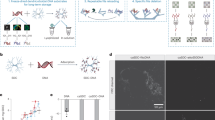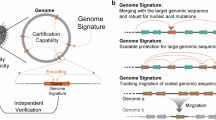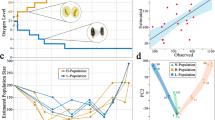Abstract
CAMPBELL'S expressed aim1 is “to describe the entropy pump whereby the species of living matter not only prevent a drop into a position of greater positive entropy at each generation, but may in fact acquire more negentropy as their reproduction continues”. This is attempted by recourse to the example of a codfish laying a million eggs the entropy content of whose genomes shows a normal distribution about a mean value in accordance with the second law of thermodynamics. On one tail of this distribution curve will be a small percentage of eggs with an entropy content equal to or less than that of the parents. There follows the crucial sentence: “These remarkable ones are most likely to grow up and repeat the reproductive process”. What follows in Campbell's communication is unexceptionable provided that this sentence is true. But what is the evidence that those eggs which are “most likely to grow and repeat the reproductive process” are those whose genomes have a lower entropy content than those of the parents ? It is at this point that the author merely evades one of the most important questions at issue in the earlier correspondence2–4. The genome may be regarded as a series of DNA molecules functioning as templates. The thermodynamic entropy content of these molecules is a function of the arrangement of the atoms, conventionally expressed as k. log D where k is the Boltzmann constant and D is a measure of the atomic disorder. A single alteration in the relative positions of adjacent nucleotide bases could convert a crucial part of the genome code to nonsense so that its capacity to support development was lost, but this could occur without an increase, indeed even with a decrease, in the thermodynamic entropy content of the genome molecules5. Stated in a more general way, this is the problem of the relationship between the amount of developmentally meaningful organization in the genome (we will call this the information content) and its entropy content. There are two problems here: first, the definition and quantization of the information content of the genome and, second, the nature of its relationship to the thermodynamic entropy content. One avenue of enquiry which offers hope in this situation would seem to be the information theory analogy.
This is a preview of subscription content, access via your institution
Access options
Subscribe to this journal
Receive 51 print issues and online access
$199.00 per year
only $3.90 per issue
Buy this article
- Purchase on SpringerLink
- Instant access to full article PDF
Prices may be subject to local taxes which are calculated during checkout
Similar content being viewed by others
References
Campbell, B., Nature, 215, 1308 (1967).
Popper, K. R., Nature, 213, 320 (1967).
Buchel, W., Nature, 213, 319 (1967).
Woolhouse, H. W., Nature, 213, 952 (1967).
Lwoff, A., Biological Order (MIT Press, 1960).
Szilard, L., Z. Physik., 53, 840 (1929).
Shannon, C. E., and Weaver, W., The Mathematical Theory of Communication (University of Illinois Press, 1949).
Brillouin, L., Science and Information Theory (Academic Press, New York, 1956).
Brillouin, L., Science and Information Theory, second ed. (Academic Press, New York, 1962).
Carnap, R., and Bar-Hillel, Y., Brit. J. Phil. Sci., 4, 147 (1953).
Linschitz, H., in Essays on the Use of Information Theory in Biology (University of Illinois Press, 1953).
Author information
Authors and Affiliations
Rights and permissions
About this article
Cite this article
WOOLHOUSE, H. Entropy and Evolution. Nature 216, 200 (1967). https://doi.org/10.1038/216200a0
Received:
Issue date:
DOI: https://doi.org/10.1038/216200a0
This article is cited by
-
Increasing Entropy of Biological Systems
Nature (1968)
-
Entropy, Evolution and Living Systems
Nature (1968)
-
Entropy, not Negentropy
Nature (1968)




Georgi Gladyshev
Thermodynamics require professionalism
Very important to remember!
Misunderstandings and mistakes in ideas about entropy
Gladyshev G. P.
Thermodynamics is used in many branches of science and human activity. Many researchers who are not professionally familiar with thermodynamics try to use this area of knowledge in their fields of activity. This is the main cause of many serious mistakes that quickly spread like a snowball in science. Thermodynamics uses the mathematical apparatus of total differentials and ideas about state functions.
State functions characterize equilibrium systems and, with an acceptable approximation, systems close to equilibrium, when it can be assumed that state functions have a real physical meaning. Systems that do not meet these criteria should not be considered thermodynamic. For example, systems far from equilibrium have no state functions. Processes occurring in these systems should not be described in terms of state functions. Thus, the thermodynamics of systems far from equilibrium I. Prigogine, in fact, is the kinetics using some non-thermodynamic entropy, which does not have a full differential.
Numerous errors are associated with misconceptions about thermodynamic entropy. Many of these errors are “born” in the life sciences.
The term "entropy" coined Rudolf Clausius. According to his model of the world (universe), he presented a statement: "The energy of the world is constant. The entropy of the world tends to the maximum". Later this statement was chosen by J. W. Gibbs as an epigraph to the paper "On the Equilibrium of Heterogeneous Substances". These scientists have given this statement in relation to their model of the universe This model corresponds to a simple isolated system of ideal gas, i.e. isolated system of ideal gas, energy and volume of this system are constant and in which the work of expansion is performed only. Entropy of such a system can only increase! It should be noted that when we say on ideal model, which would correspond to the real universe, it would be necessary to accept the unreal assumption that any form of energy real universe will be transformed into thermal energy. Only in this case, also under additional unrealistic assumptions, the real universe "would turn" into the model of ideal system of Clausius - Gibbs. However, lovers of science have applied representations on simple systems to systems of other types, in which the interactions takes place between particles of different nature (interactions of molecules or other objects of different hierarchies) and to systems which interact with the environment. Some scientists, who are not professionals in the relevant fields of knowledge, have not escaped such errors. This has led to unimaginable confusion. This has slowed down the development of science, more than on a century. There are thousands of publications in scientific journals and popular literature containing marked misunderstandings. To these were added incorrect ideas on the negentropy and on the dissipative structures in the living world, and the false identification of "the information entropy" with the thermodynamic entropy. The origin of life and its evolution can be easily explained from the standpoint of hierarchical near equilibrium thermodynamics of complex dynamic systems. This thermodynamics is established on a solid foundation of equilibrium thermodynamics - thermodynamics of Rudolf Clausius, J. W. Gibbs and other great scientists.
It should also be noted that many non-professional authors use erroneous terminology. These errors are distributed in the literature, which creates incredible confusion. For example, the terms “isolated system” are sometimes replaced by the term “closed system” and vice versa. Of course, from the standpoint of thermodynamics, this is completely unacceptable.
Another example of incorrect use of terms in thermodynamics is associated with the concepts of “simple thermodynamic system” and “complex thermodynamic system”. A simple system in thermodynamics is a system in which either no work is done or only the work of expansion is performed. A complex system in thermodynamics is a system in which not only the work of expansion is performed.
A serious misunderstanding is connected with the identification of the concepts of thermodynamic entropy and the Shannon informational entropy. The meaning of these concepts is completely different Nevertheless, now some researchers are trying to refute this assertion.
These comments relate to the majority of articles devoted to the second law and entropy in Wikipedia. Apparently, many of these articles need to be refined or revised.
References
Gladyshev G.P. On General Physical Principles of Biological Evolution, International Journal of Research Studies in Biosciences, 2017, Volume 5, Issue 3, Page No: 5-10. https://www.arcjournals.org...
Hierarchical thermodynamics https://en.everybodywiki.co...